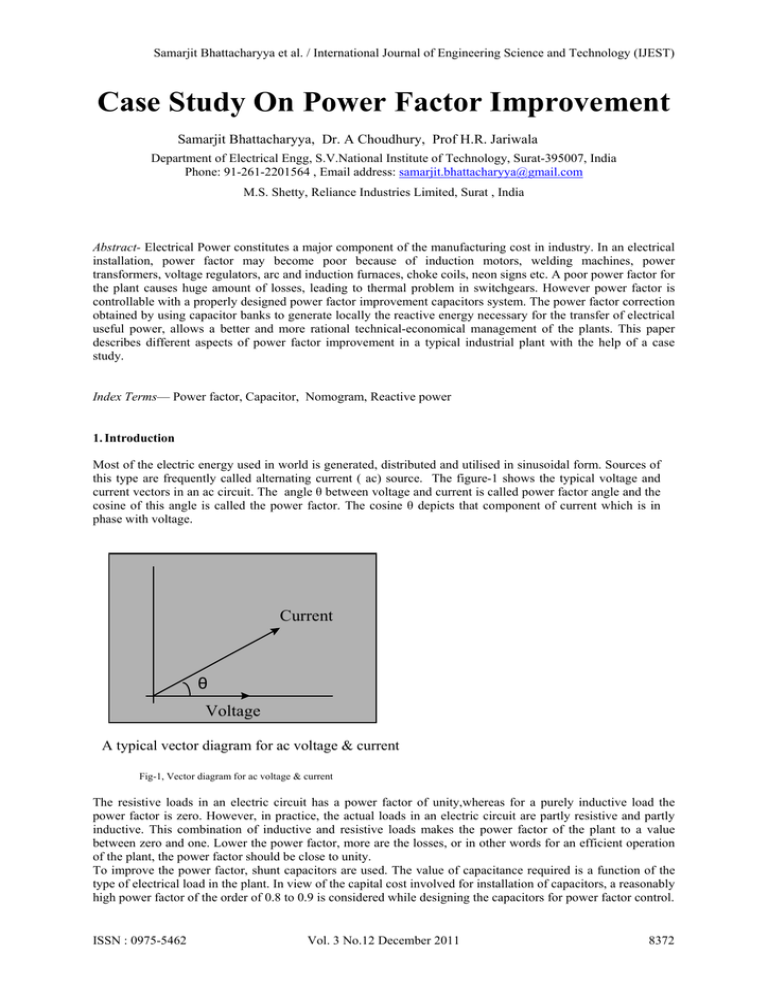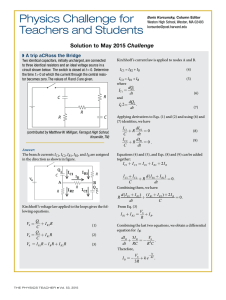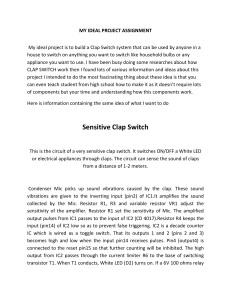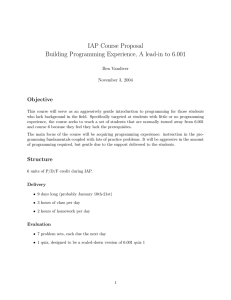Case Study On Power Factor Improvement
advertisement

Samarjit Bhattacharyya et al. / International Journal of Engineering Science and Technology (IJEST) Case Study On Power Factor Improvement Samarjit Bhattacharyya, Dr. A Choudhury, Prof H.R. Jariwala Department of Electrical Engg, S.V.National Institute of Technology, Surat-395007, India Phone: 91-261-2201564 , Email address: samarjit.bhattacharyya@gmail.com M.S. Shetty, Reliance Industries Limited, Surat , India Abstract- Electrical Power constitutes a major component of the manufacturing cost in industry. In an electrical installation, power factor may become poor because of induction motors, welding machines, power transformers, voltage regulators, arc and induction furnaces, choke coils, neon signs etc. A poor power factor for the plant causes huge amount of losses, leading to thermal problem in switchgears. However power factor is controllable with a properly designed power factor improvement capacitors system. The power factor correction obtained by using capacitor banks to generate locally the reactive energy necessary for the transfer of electrical useful power, allows a better and more rational technical-economical management of the plants. This paper describes different aspects of power factor improvement in a typical industrial plant with the help of a case study. Index Terms— Power factor, Capacitor, Nomogram, Reactive power 1. Introduction Most of the electric energy used in world is generated, distributed and utilised in sinusoidal form. Sources of this type are frequently called alternating current ( ac) source. The figure-1 shows the typical voltage and current vectors in an ac circuit. The angle θ between voltage and current is called power factor angle and the cosine of this angle is called the power factor. The cosine θ depicts that component of current which is in phase with voltage. Current θ Voltage A typical vector diagram for ac voltage & current Fig-1, Vector diagram for ac voltage & current The resistive loads in an electric circuit has a power factor of unity,whereas for a purely inductive load the power factor is zero. However, in practice, the actual loads in an electric circuit are partly resistive and partly inductive. This combination of inductive and resistive loads makes the power factor of the plant to a value between zero and one. Lower the power factor, more are the losses, or in other words for an efficient operation of the plant, the power factor should be close to unity. To improve the power factor, shunt capacitors are used. The value of capacitance required is a function of the type of electrical load in the plant. In view of the capital cost involved for installation of capacitors, a reasonably high power factor of the order of 0.8 to 0.9 is considered while designing the capacitors for power factor control. ISSN : 0975-5462 Vol. 3 No.12 December 2011 8372 Samarjit Bhattacharyya et al. / International Journal of Engineering Science and Technology (IJEST) 2. Working Principle Reactive power can be described as a by-product of electrical energy system. It circulates through the generators, transmission lines and transformers, but it is not delivered anywhere. It must be recognised and accounted for, however, since it plays an important role in the stability, cost of power and voltage control of the system. Reactive power is measured much like active power, that is, through a vector product of current and voltage. Reactive power does not dissipate any energy other than the losses it creates through current circulation in the equipment and the transmission lines. Every kind of load except a perfect heating load generates reactive power. Reactive power can be leading ( current vector leading the voltage vector) or it can be lagging ( current vector lagging the voltage vector). Since reactive power can be leading or lagging, the total balance must be zero. The leading power is because of capacitance in the power circuit. Similarly, the lagging power is because of inductance in the power circuit. Motors, transformers in the industries are large source of lagging ( inductive) power. In order to control excessive lagging (inductive) power, capacitors may have to be connected in the power circuit. Since capacitors are the source of leading power, they compensate the lagging power created by common equipment in the industries like motors and transformers. Capacitors should be located as near to the load as possible. However, this is not practically possible because of the cost, availability of space and other environmental conditions. Capacitors can be located as in : i. Individual Compensation In such installations capacitors are installed parallel to the equipment and are controlled by a common switch. This is generally suited for high output induction motors, furnaces, transformers. ii. Group compensation This method resorts to compensation of the group of loads fed from the same bus bar. This is particularly useful when small loads are connected to a common bus bar. iii. Central Compensation This can apply to HT and/or LT capacitors. The output of capacitors has to be divided in a number of steps with auto / manual control depending upon the initial power factor of the load and its variation. 3. Installation Guidelines capacitors for overhead distribution system can be pole-mounted in banks of 300 to 3600 kVAr at nearly any primary voltage up to 34.5 kV phase to phase. Pad mounted capacitor are used for underground distribution system in the same range of sizes and voltage ratings. ISSN : 0975-5462 Vol. 3 No.12 December 2011 8373 Samarjit Bhattacharyya et al. / International Journal of Engineering Science and Technology (IJEST) Common Capacitors Connections Single Phase Ground to Neutral Grounded Wye Grnd Ungrounded Wye Delta Common Methods for connecting Power Factor Capacitors Fig-2, Common capacitor connections The above figure-2 shows four of the most common capacitors connections : 3-phase grounded wye, 3-phase ungrounded wye, 3-phase delta and single phase. Grounded and ungrounded wye connections are usually made on primary circuits whereas delta and single phase connections are usually made on low voltage circuits. The majority of the power capacitor requirement installed on primary distribution feeders is connected grounded wye. There are a number of advantages from this type of connection. With the grounded wye connection, switch tanks and frames are at ground potential. This provides increased personnel safety. Grounded wye connections provide faster operation of the series fuse in case of capacitor failure. Grounded capacitors can bypass some line surge to the ground and therefore exhibit a certain degree of self protection from transient voltages and lighting surges. The grounded wye connections also provide a low-impedance path for harmonics. If the capacitors are electrically connected ungrounded wye, the maximum full current would be limited to three times the line current. If too much fault current is available, generally above 5000 A, the use of current limiting fuses must be considered. 4. Estimation of KVAR required to improve power factor: A quick estimate of capacitive KVAR required for improvement of power factor at a given load can be made from the Nomogram shown in the figure. However in most cases the capacitor bank rating has to be carefully selected after due consideration of rated voltage of the system, system over voltages, harmonics in the system, rating of series reactor etc. A Nomogram ( fig-3) is used for calculating the necessary capacitor rating QC (kVAr) required to improve the power factor of a load P (KW) : QC = K x P Example : for a load P of 1500 KW, to improve power factor from 0.6 to 0.85, the factor K from Nomogram is 1.4. QC = 1.4 x 1500 = 2100 kVAr ISSN : 0975-5462 Vol. 3 No.12 December 2011 8374 Samarjit Bhattacharyya et al. / International Journal of Engineering Science and Technology (IJEST) Present Power Factor Desired Power Factor 0.4 o,45 o.5 0.55 0.6 0.65 0.7 0.75 2.3 2.2 2.1 2.0 1.9 1.8 1.7 1.6 1.5 1.4 1.3 1.1 1.0 0.9 0.8 0.7 0.6 0.5 0.4 0.3 0.2 0.1 0 1.0 0.9 0.8 0.7 0.6 0.5 0.4 K Nomogram Fig-3,Nomogram ISSN : 0975-5462 Vol. 3 No.12 December 2011 8375 Samarjit Bhattacharyya et al. / International Journal of Engineering Science and Technology (IJEST) Case Study: Here in this case study we are considering a industrial installation where there is one HT switchgear with two incomers and four LT switchgear with two incomers. We have calculated resistance of power cables and busbars which is required to calculate power loss in the existing power factor. We have taken desired power factor as 0.95 and again calculated the losses at new power factor. The difference between the two is 4.5 kilowatt per hour. In one year this gain will be 39420 kwhr . If we take Energy cost as Rs 6.5per kwhr, there will be saving of gain will be Rs 2.56 lakhs. In addition there will be considerable reduction in heating in these switchgears which will improve the reliability of the switchgear and the power system. Total reactive power required to improve power factor to 0.95 is 967 Kvar Parameters with Existing Power Factor P.F. PMCC2 IC1 IC2 PMCC3 IC1 IC2 PMCC4 IC1 IC2 PMCC5 5E PMCC8 IC1 IC2 Main IC1 Main IC2 kW kVAR kVA I(LV) I(HV)(line) I(HV)(phase) 0.784 0.765 342 345 270 342 437 445 607.975 619.105 38.22871 38.92855 22.07200196 22.47606607 0.762 0.852 365 367 307 223 475 432 660.842 601.018 41.55294 37.79131 23.99130648 21.81946189 0.909 0.86 98 88 45 52 109 101 151.646 140.516 9.535307 8.835468 5.505373487 5.101309378 0.874 930 518 1065 1481.68 93.16607 53.79103453 0.8 0.67 0.686 0.85 40 37 1385 4785 30 39 1476 2975 49 55 2020 5620 68.1711 76.5185 176.709 491.637 4.286514 4.811393 35.34187 98.32738 2.474892668 2.77794075 20.40523751 56.77100733 Chart:-1 Parameters with existing Power Factor Parameters with Desired Power Factor PMCC2 IC1 IC2 PMCC3 IC1 IC2 PMCC4 IC1 IC2 PMCC5 5E PMCC8 IC1 IC2 P.F. kW kVAR kVA I(LV) I(HV) 0.95 0.95 342 345 112.409964 113.3960163 360 363.1578947 500.8487 505.2421 31.49276 31.76901 18.1828849 18.3423839 157.590036 228.6039837 0.95 0.95 365 367 119.9696984 120.6270666 384.2105263 386.3157895 534.5315 537.4604 33.61069 33.79486 19.4057105 19.5120432 187.0303016 102.3729334 0.95 0.95 98 88 32.21104231 28.92420126 103.1578947 92.63157895 143.518 128.8733 9.02424 8.103399 5.21030035 4.67863705 12.78895769 23.07579874 0.95 930 305.6762178 978.9473684 1361.957 85.6382 49.444687 212.3237822 0.95 0.95 40 37 13.14736421 12.16131189 42.10526316 38.94736842 58.57879 54.18538 3.683363 3.407111 2.12665321 1.96715422 16.85263579 26.83868811 ISSN : 0975-5462 Vol. 3 No.12 December 2011 I(HV)(phase) Required Reactive Power 8376 Samarjit Bhattacharyya et al. / International Journal of Engineering Science and Technology (IJEST) Chart:-2 Parameters with Desired Power Factor Calculation for resistance BUSBAR LV(Al. ρ=.03816(Ω sq.mm)/m at TRANSFORMER 20degC RESISTANCE CABLE HV(185sq mm Al.) NET RESISTANCE R(ohm/k CABLE RESISTANCE THICKN WIDTH( LENG RESISTANCE( HV(ohm) LV(ohm) LENGTH( m)at ESS(m TH(m (ohm) mm) 70degC meter) m) eter) ohm) PMCC2 IC1 IC2 PMCC3 IC1 IC2 PMCC4 IC1 IC2 PMCC5 5E PMCC8 IC1 IC2 HT IC1 IC2 HV(ohm) LV(ohm) 0.198 0.198 70 75 0.01386 0.01485 10 10 150 150 7 7 0.00017808 0.00017808 0.257 0.257 0.000365 0.27086 0.00054308 0.000365 0.27185 0.00054308 0.198 0.198 65 70 0.01287 0.01386 10 10 150 150 8 8 0.00020352 0.00020352 0.257 0.257 0.000365 0.26987 0.00056852 0.000365 0.27086 0.00056852 0.198 0.198 65 60 0.01287 0.01188 10 10 150 150 7 7 0.00017808 0.00017808 0.257 0.257 0.000365 0.26987 0.00054308 0.000365 0.26888 0.00054308 0.198 70 0.01386 10 150 7 0.00017808 0.257 0.000365 0.27086 0.00054308 0.198 280 0.05544 0.198 275 0.05445 CABLE HV(630sq mm Al.) 10 10 150 150 6 6 0.00015264 0.00015264 0.257 0.257 0.000365 0.31244 0.00051764 0.000365 0.31145 0.00051764 10 10 160 160 7 7 0.00016695 0.00016695 0.318 0.318 0.003505 0.003505 0.0582 0.0582 1500 1500 0.0873 0.0873 0.4053 0.00367195 0.4053 0.00367195 Chart-3: Calculation of resistance Loss Calculation before pf correction CURRENT(before) NET RESISTANCE HVt/f(ohm) HVline(ohm) LV(ohm) HVline(amp) HVphase(amp) LV(amp) PMCC2 IC1 IC2 PMCC3 IC1 IC2 PMCC4 IC1 IC2 PMCC5 5E PMCC8 IC1 IC2 HT IC1 IC2 LOSSES(before) HV(watts) LV(watts) 0.257 0.257 0.01386 0.00054 38.2287074 0.01485 0.00054 38.92854643 22.07200196 607.97462 436.377 22.47606607 619.10459 457.0013 0.257 0.257 0.01287 0.00057 41.55294282 0.01386 0.00057 37.791308 23.99130648 660.84198 510.4402 21.81946189 601.01839 426.4484 0.257 0.257 0.01287 0.00054 9.535306879 0.01188 0.00054 8.835467842 5.505373487 151.64584 26.87885 5.101309378 140.51587 22.84626 0.257 0.01386 0.00054 53.79103453 1481.6773 0.257 0.257 0.05544 0.00052 4.286514102 0.05445 0.00052 4.81139338 2.474892668 68.171068 7.778445 2.77794075 76.518545 9.731244 0.318 0.318 0.0873 0.00367 35.34187137 0.0873 0.00367 98.3273847 20.40523751 176.70936 724.3462 56.77100733 491.63692 5606.813 93.1660718 Total Losses = 2591.78 602.2211 624.4722 0 744.8387 616.0877 0 37.46676 32.16887 0 3576.781 0 7.216877 9.092483 0 343.9831 2662.607 Total Losses(before) (watts) 1038.598122 1081.473499 1255.278904 1042.536087 64.34560213 55.01513542 6168.561154 14.99532124 18.82372692 1068.329265 8269.419376 20077.37619 Chart-4: Loss calculation at existing power factor ISSN : 0975-5462 Vol. 3 No.12 December 2011 8377 Samarjit Bhattacharyya et al. / International Journal of Engineering Science and Technology (IJEST) Loss Calculation after pf correction NET RESISTANCE HVt/f(ohm HVline(ohm ) ) LV(ohm) PMCC2 IC1 IC2 PMCC3 IC1 IC2 PMCC4 IC1 IC2 PMCC5 5E PMCC8 IC1 IC2 HT IC1 IC2 CURRENT(after) LOSSES(after) Total Losses(after) HVline(amp ) HVphase(amp) LV(amp) HV(watts) LV(watts) (watts) 0.257 0.257 0.01386 0.000543 0.01485 0.000543 31.4927567 31.7690089 0.257 0.257 0.01287 0.000569 0.01386 0.000569 33.6106906 33.7948588 0.257 0.257 0.01287 0.000543 0.01188 0.000543 9.02424021 8.10339938 0.257 0.01386 0.000543 85.638198 0.257 0.257 0.05544 0.000518 0.05445 0.000518 3.68336335 3.4071111 0.318 0.318 0.0873 0.003672 0.0873 0.003672 25.5072912 88.1244682 18.18288491 500.8487 296.1447 408.6938 704.8385687 18.3423839 505.2421 304.3606 415.8954 720.2559244 0 19.4057105 534.5315 333.9613 487.3192 821.2805341 19.51204316 537.4604 341.0232 492.6743 833.6975418 0 5.210300355 143.518 24.07479 33.55815 57.63294526 4.678637053 128.8733 19.21722 27.05897 46.27618754 0 49.44468704 1361.957 2189.867 3022.121 5211.987262 0 2.126653206 58.57879 5.743457 5.328806 11.07226282 1.967154216 54.18538 4.879769 4.559459 9.439227911 0 14.72707345 127.5365 377.3078 179.1788 556.4866145 50.88017795 440.6223 4503.603 2138.706 6642.308767 Total Losses 15615.27584 Chart-5: Loss calculation after improved power factor. It is evident from the above charts that power factor of PMCC-8 , I/C-2 and main I/C-2 are very low in comparison to other switchgears. Immediate steps are to be taken to improve the power factor of both the switchgears. KVAR required to design the capacitor bank can be taken from chart-2 or using Nomogram as discussed in the chapter-4 of this paper. 5. Conclusion The low power factor is highly undesirable as it causes an increase in current, resulting in additional losses of active power in all the elements of power system from power station generator down to utilisation devices. In order to ensure most favourable conditions for a supply system from engineering and economical standpoint, it is important to have power factor as close to unity as possible. 6. References [1] Marcos, T.Galelli, Marcio, S.Vilela, “Proposal of a timer controller with constant switching frequency and power factor correction”, IEEE, 2005.pp, 102_109 International Journal of Computer and Electrical Engineering, Vol. 1, No. 2, June 2009 1793-8163 - 187 Oscar GarcíaJosé A. Cobos, Roberto Pedro Alou, and Javier Uceda, “Single Phase Power Factor Correction:A Survey”, IEEE Transactions on Power Electronics, Vol. 18, No. 3, May 2003. Bhim SinghBrij N. Singh, Ambrish Chandra, , Kamal AHaddad, , Ashish Pandey, , and Dwarka P. Kothari, “A Review of SinglePhase Improved Power Quality AC–DC Converter”, IEEE Transactions on Industrial Electronics, Vol. 50, No. 5, October 2003. Martin F.Schlecht, Brett A.Miwa, “Active Power Factor Correction for Switching Power Supplies”, IEEE Transactions on Power Electronics, Vol.PE-2, no.4, October 1987. A.Pandey, Prof B.Singh, “Comparative Evaluation of Single-phase Unity Power Factor ac-dc Boost Converter Topologies”, IEEE proc, November 30, 2004.pp, 102-109 ‘POWER ELECTRONICS - Converters, Applications and Design’, Mohan, Under land, Robbins, John Wiley & Sons POWER ELECTRONICS – Circuits, Devices and Applications’, Muhammad H. Rashid, Prentice Hall of India Private Limited ‘POWER ELECTRONICS’, M D Singh, K B Khanchandani, Tata McGraw – Hill Publishing Company Limited. [2] [3] [4] [5] [6] [7] [8] [9] ISSN : 0975-5462 Vol. 3 No.12 December 2011 8378





